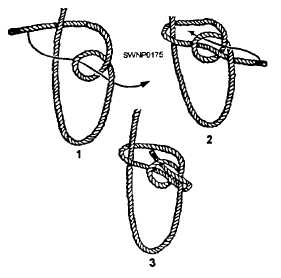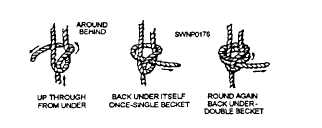
Figure 4-16. - Running bowline.

Figure 4-17. - Becket bend.
Becket Bend
An especially good knot for bending together two lines that are unequal in size is the type known as the BECKET BEND. The simple procedure and necessary instructions for tying a becket, single and double, are given in figure 4-17.
Clove Hitch
When it comes to bending to a timber or spar or anything that is round or nearly round, the familiar CLOVE HITCH is an ideal selection. Figure 4-18 shows how this knot is made. A clove hitch will not jam or pull out; however, if a clove hitch is slack, it might work itself out, and for that reason, it is a good idea to make a HALF HITCH in the end, as shown in figure 4-19, view 1. A half hitch never becomes a whole hitch. Add a second one and all you have is two half hitches, as shown in figure 4-19, view 2.
The SCAFFOLD HITCH is used to support the end of a scaffold plank with a single line. To make the scaffold hitch, lay the running end across the top and around the plank, then up and over the standing

Figure 4-18. - Clove hitch.
Continue Reading